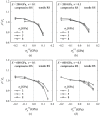Investigation on Indentation Cracking-Based Approaches for Residual Stress Evaluation
- PMID: 28772765
- PMCID: PMC5506943
- DOI: 10.3390/ma10040404
Investigation on Indentation Cracking-Based Approaches for Residual Stress Evaluation
Abstract
Vickers indentation fracture can be used to estimate equibiaxial residual stresses (RS) in brittle materials. Previous, conceptually-equal, analytical models were established on the assumptions that (i) the crack be of a semi-circular shape and (ii) that the shape not be affected by RS. A generalized analytical model that accounts for the crack shape and its change is presented. To assess these analytical models and to gain detailed insight into the crack evolution, an extended finite element (XFE) model is established. XFE analysis results show that the crack shape is generally not semi-circular and affected by RS and that tensile and compressive RS have different effects on the crack evolution. Parameter studies are performed to calibrate the generalized analytical model. Comparison of the results calculated by the analytical models with XFE results reveals the inaccuracy inherent in the previous analytical models, namely the neglect of (the change of) the crack aspect-ratio, in particular for tensile RS. Previous models should therefore be treated with caution and, if at all, used only for compressive RS. The generalized model, on the other hand, gives a more accurate description of the RS, but requires the crack depth.
Keywords: extended finite element analysis; fracture toughness; indentation fracture; residual stress.
Conflict of interest statement
The authors declare no conflict of interest.
Figures












Similar articles
-
The bending strength of tablets with a breaking line--Comparison of the results of an elastic and a "brittle cracking" finite element model with experimental findings.Int J Pharm. 2015 Nov 10;495(1):485-499. doi: 10.1016/j.ijpharm.2015.09.004. Epub 2015 Sep 9. Int J Pharm. 2015. PMID: 26363109
-
Residual micro-stress distributions in heat-pressed ceramic on zirconia and porcelain-fused to metal systems: Analysis by FIB-DIC ring-core method and correlation with fracture toughness.Dent Mater. 2015 Nov;31(11):1396-405. doi: 10.1016/j.dental.2015.08.158. Epub 2015 Sep 11. Dent Mater. 2015. PMID: 26365988
-
Nanomechanical characterization of alumina coatings grown on FeCrAl alloy by thermal oxidation.J Mech Behav Biomed Mater. 2016 Apr;57:310-20. doi: 10.1016/j.jmbbm.2016.01.027. Epub 2016 Feb 1. J Mech Behav Biomed Mater. 2016. PMID: 26875145
-
Pyrolytic carbon indentation crack morphology.J Heart Valve Dis. 1996 Jun;5 Suppl 1:S65-71. J Heart Valve Dis. 1996. PMID: 8794035
-
Indentation fracture resistance of brittle materials using irregular cracks: A review.Heliyon. 2023 Aug 22;9(9):e19361. doi: 10.1016/j.heliyon.2023.e19361. eCollection 2023 Sep. Heliyon. 2023. PMID: 37662782 Free PMC article. Review.
Cited by
-
Phase-Field Modeling of Fused Silica Cone-Crack Vickers Indentation.Nanomaterials (Basel). 2022 Jul 9;12(14):2356. doi: 10.3390/nano12142356. Nanomaterials (Basel). 2022. PMID: 35889580 Free PMC article.
-
Determination of Mechanical and Fracture Properties of Silicon Single Crystal from Indentation Experiments and Finite Element Modelling.Materials (Basel). 2021 Nov 14;14(22):6864. doi: 10.3390/ma14226864. Materials (Basel). 2021. PMID: 34832266 Free PMC article.
-
Estimation of Residual Stress in Selective Laser Melting of a Zr-Based Amorphous Alloy.Materials (Basel). 2018 Aug 20;11(8):1480. doi: 10.3390/ma11081480. Materials (Basel). 2018. PMID: 30127268 Free PMC article.
References
-
- Warren A.W., Guo Y.B., Weaver M.L. The influence of machining induced residual stress and phase transformation on the measurement of subsurface mechanical behavior using nanoindentation. Surf. Coat. Technol. 2006;200:3459–3467. doi: 10.1016/j.surfcoat.2004.12.028. - DOI
-
- Golovin Y.I. Nanoindentation and mechanical properties of solids in submicrovolumes, thin near-surface layers, and films: A Review. Phys. Solid State. 2008;50:2205–2236. doi: 10.1134/S1063783408120019. - DOI
-
- Groth B.P., Langan S.M., Haber R.A., Mann A.B. Relating residual stresses to machining and finishing in silicon carbide. Ceram. Int. 2016;42:799–807. doi: 10.1016/j.ceramint.2015.08.179. - DOI
-
- Wang C., Jiang C., Cai F., Zhao Y., Zhu K., Chai Z. Effect of shot peening on the residual stresses and microstructure of tungsten cemented carbide. Mater. Des. 2016;95:159–164. doi: 10.1016/j.matdes.2016.01.101. - DOI
-
- Rossini N.S., Dassisti M., Benyounis K.Y., Olabi A.G. Methods of measuring residual stresses in components. Mater. Des. 2012;35:572–588. doi: 10.1016/j.matdes.2011.08.022. - DOI
LinkOut - more resources
Full Text Sources
Other Literature Sources

